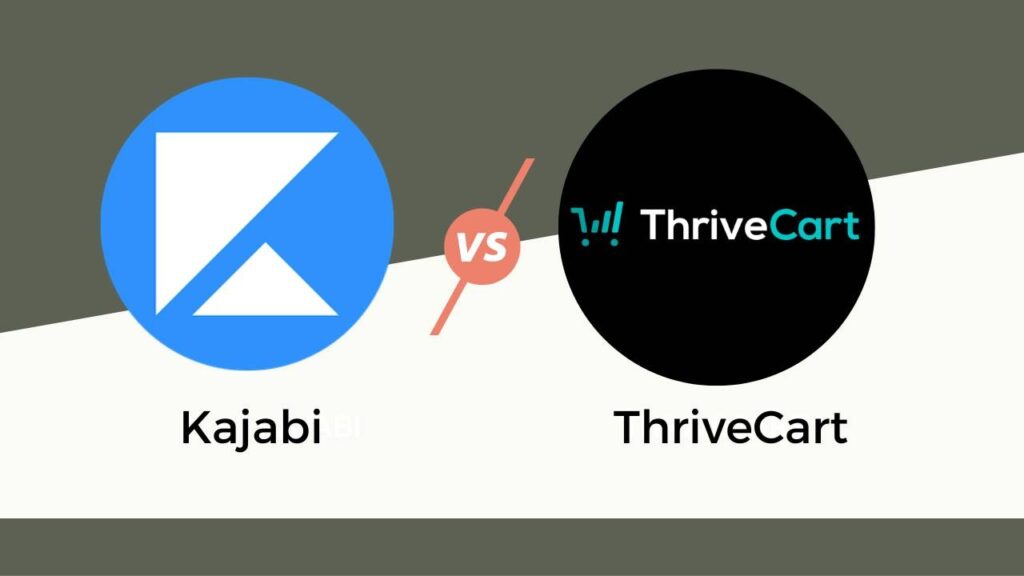ThriveCart vs. Kajabi: Which Platform is Right for Your Online Business?

Your conversion rates and revenue growth are greatly impacted by the platform you choose if you are an established business owner selling digital products online. Naturally, Thrivecart and Kajabi are names you are probably familiar with if you are an online business owner. These are two well-known platforms that may assist you with online marketing and sales of your memberships, courses, and digital goods.
However, because they each have unique characteristics and advantages, choosing between the two might be difficult. ThriveCart is well known for its powerful shopping cart features, while Kajabi is praised for being a one-stop shop for digital entrepreneurs and online course developers.
What is ThriveCart?
ThriveCart is a flexible eCommerce solution designed to make online sales and payment processing more efficient. With configurable checkout pages, connected payment methods like PayPal and Stripe, and strong affiliate management, it shines at offering a flawless checkout experience.
Businesses that want a strong yet user-friendly solution for managing transactions, product sales, and simple affiliate programs will find ThriveCart to be a good fit. It is a great option for people that offer digital products and want to streamline your sales funnel because it also enables flexible payment plans and subscription models.
ThriveCart Is Perfect For:
- Entrepreneurs who already have platforms or websites.
- Companies that sell tangible or digital goods.
- Businesses looking for strong affiliate management solutions.
What is Kajabi?
In contrast, Kajabi is an all-in-one platform that offers a full range of tools for building and marketing membership sites and online courses, going beyond eCommerce. Kajabi offers a comprehensive method for managing customers, marketing, and creating courses. It has features including sophisticated marketing automation, membership site administration, and integrated course-building tools.
Additionally, Kajabi provides a variety of templates and pre-made marketing funnels, which makes it perfect for company owners and companies who want to apply sophisticated marketing techniques and provide instructional content.
Kajabi Is Ideal For:
- Consultants, coaches, and instructors of courses.
- Entrepreneurs want an ecosystem that manages the production and marketing of content.
- Companies that prioritized fostering relationships and developing communities.
ThriveCart and Kajabi Features Comparison
Depending on your requirements and tastes, both Thrivecart and Kajabi provide special features and advantages. While Kajabi is a more all-inclusive platform made for developing and selling online courses as well as fostering a community around them, Thrivecart is a fantastic choice for companies who wish to concentrate on marketing and selling their goods and services.
A web-based shopping cart software called ThriveCart enables company owners to set up and run their online ventures. The following are the main characteristics:
Affiliate Management
ThriveCart: Customizing compensation rates for various affiliates or particular items is one of ThriveCart’s best features. This implies that you may provide greater commission rates to top-performing affiliates and enticing commission rates to new affiliates to market your goods. ThriveCart also provides a range of tracking options, including IP addresses, discount codes, and cookie-based monitoring. This makes it simple to monitor your affiliates’ progress and modify your approach as necessary.
Kajabi: You may also generate unique promo codes or affiliate links for your partners to distribute to their audience using Kajabi’s affiliate management function. In this manner, you can monitor the traffic sources that are producing the most leads or sales and adjust your marketing strategy appropriately.
Checkout Process and Payment Management
ThriveCart: To improve user experience and increase sales, ThriveCart provides checkout pages that are configurable and conversion-focused. One-click bump offers, downsells, and upsells are among the features that let companies easily raise the average order value. Additionally, ThriveCart offers integrated tax computation based on the location of the consumer, guaranteeing adherence to global tax regulations and offering customers clear billing.
Kajabi: Within its platform, Kajabi provides a simple checkout procedure. It does not, however, include all of ThriveCart’s sophisticated customization and optimization options, including several upsells and downsells. Sales tax and VAT are not automatically calculated by Kajabi depending on the location of the client; human modifications may be necessary to guarantee compliance with tax laws.
Funnel Building and Sales Automation
ThriveCart: With its expertise in post-buy funnels, ThriveCart enables companies to design upsells and downsells that start after the first transaction. It does not, however, have sophisticated automation features and only provides a small number of funnel phases.
Kajabi: With its powerful funnel-building tool, Kajabi manages the complete customer experience, from lead generation to conversion. It comes with pre-made layouts, editable pages, email campaigns, and the flexibility to add more than one offer or price. With the help of branching logic and conditional triggers, Kajabi facilitates sophisticated automations that allow for individualized customer experiences and effective sales procedures.
Content Hosting and Delivery
ThriveCart: Since ThriveCart does not host content directly, video hosting requires connection with third-party services like Vimeo or YouTube. This calls for extra procedures for the transmission of content.
Kajabi: Kajabi provides integrated hosting for a range of digital goods, such as subscriptions, online courses, and downloaded materials. Within the platform, it offers tools for managing, creating, and distributing content.
Pricing Structure
ThriveCart:
The price structure of ThriveCart is simple and economical:
Access for Life: $495 for the Standard plan and $690 for the Pro plan, which comes with extra features like comprehensive reporting and affiliate administration, is the one-time cost.
No Ongoing Expenses: The program is yours for life after payment.
Kajabi:
Kajabi has a subscription-based business strategy, which might be more expensive:
Essential services, including email campaigns, pipelines, and course hosting, are included in the $149/month Basic Plan.
Growth Plan: $199/month; includes white-labeling choices, affiliates, and sophisticated automations.
The Pro Plan, which costs $399 a month, provides all the features, including additional user accounts and premium support.
Both ThriveCart and Kajabi have special characteristics, but which one is better for you will depend on your particular requirements.
Use Cases
ThriveCart:
ThriveCart was created mainly for companies looking to optimize their affiliate marketing and sales procedures. Its characteristics address certain use scenarios, such as:
Online retailers:
Perfect for companies that need high-converting checkout pages that offer digital or physical goods. Upsells, downsells, and bump offers, together with ThriveCart’s sophisticated checkout customisation, make it a popular option for e-commerce platforms looking to raise average order value.
Affiliate-Powered Companies:
Ideal for companies that use affiliate marketing extensively. Businesses can accurately analyze affiliate performance and provide appropriate incentives thanks to ThriveCart’s configurable compensation schemes and comprehensive tracking methods.
Course Creators (External Hosting):
It works well for creators who choose platforms like Vimeo, Teachable, or YouTube for course delivery or who already have a content hosting option. These platforms may be integrated with ThriveCart to manage checkout optimization and payment processing.
Services Based on Subscriptions:
ThriveCart’s comprehensive subscription management solutions, which include customizable billing choices and subscription statistics, are advantageous for businesses that provide recurring subscription items.
ThriveCart: Who Should Use It?
ThriveCart is ideal for companies and entrepreneurs that want to increase conversions, streamline their checkout procedure, and leverage affiliate marketing to expand. It is especially appropriate for people who already use or prefer to use third-party technologies for customer contact and content storage.
Kajabi:
Kajabi is an all-in-one platform designed for entrepreneurs and creative who want to easily create, host, and promote their digital goods. Among its applications are:
Teachers and Course Developers:
Perfect for people and institutions developing and delivering online courses. The process of producing and marketing instructional materials is streamlined by Kajabi’s integrated course-building tools, video hosting, and student management capabilities.
Sites for Members:
Ideal for companies that provide membership-based services or content. Creators may create private communities with gated content, subscription pricing, and automatic member onboarding by utilizing Kajabi’s membership capabilities.
Sellers of Digital Products:
Ideal for business owners that provide downloaded materials such as templates or eBooks. From product development to delivery, Kajabi offers comprehensive assistance on a single platform.
Advisors and Coaches:
Perfect for service-based professions such as business consultants and life coaches. Service delivery is streamlined and individualized client communication is made possible by Kajabi’s integrated CRM, email marketing, and automation capabilities.
Kajabi: Who Should Use It?
Kajabi is a fantastic option for entrepreneurs and creators seeking a one-stop shop to develop, promote, and sell their digital goods. It is especially advantageous for people who wish to consolidate all of their activities into a single platform without requiring extra third-party solutions.
Ease of Use and Integration
ThriveCart
The main feature of ThriveCart that really sticks out to me is how simple it is to use; there isn’t really a learning curve like there is with other tools, and it’s practically impossible to make a mistake.
ThriveCart offers a number of features, such as: creating a product, which includes making upsells, downsells, and product bumps; creating high-converting cart pages; setting up payment processors; and integrating with other software.
While each of these tasks may require a few steps to complete, the steps involved flow quite easily from one to the next.
ThriveCart easily connects with CRMs like ActiveCampaign and platforms like WordPress and Shopify. It is perfect for companies that currently use a variety of technologies because of its versatility.
Kajabi
Kajabi makes managing an online company easier with its pre-made templates and user-friendly drag-and-drop editor. Exploring all the features, however, can take more time because it’s an all-in-one platform.
Although Kajabi integrates effectively with analytics tools like PayPal, Stripe, and Zapier, its restricted environment may restrict its ability to connect with other third-party products.
Conclusion
The choice between ThriveCart and Kajabi ultimately comes down to your particular business requirements. ThriveCart is a great option if you’re searching for a robust shopping cart system that cuts down on recurrent costs and maximizes revenue.
However, if you’re an online instructor or business owner in need of a comprehensive platform to handle everything from product development to marketing and community involvement, Kajabi is your best option.
This post may contain affiliate links and we may earn commissions. Learn more in our disclosure.



